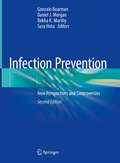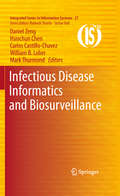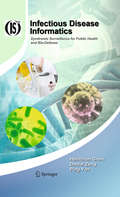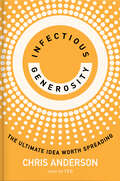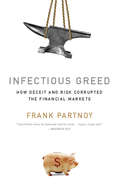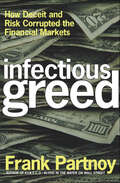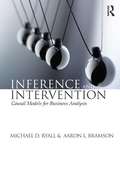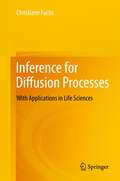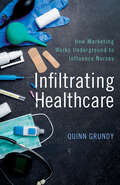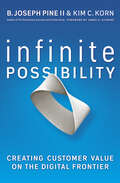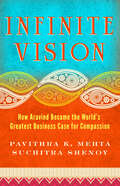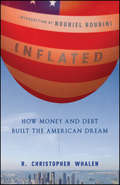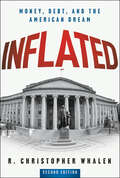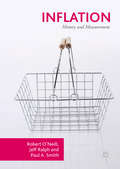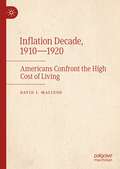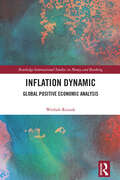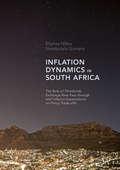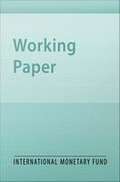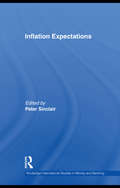- Table View
- List View
Infection Prevention: New Perspectives and Controversies
by Gonzalo Bearman Daniel J. Morgan Rekha K. Murthy Susy HotaThe first edition of Infection Prevention reviewed evolving areas in infection prevention on topics including contact precautions, technology implementation, specific infections, and care in various settings. It summarized the current data on infection prevention, presents controversies on the various topics, and includes recommendations for patient safety. Addressing hot topics such as MRSA, C. difficile vaccination, mandatory flu vaccines, and CLABSI, this is the only text to include prevention and control overviews across a range of infection issues. Written by experts in the field, this successor edition will update current chapters on the most cutting-edge models of care on emerging and evolving topics in infectious diseases. It will also include new material and chapters on high-level disinfection, diagnostic test stewardship, unique pathogens units, outpatient antibiotic stewardship, outpatient antibiotic therapy, as well as a chapter on infection prevention metrics: how much can we prevent healthcare associated infections and how hard should we try. The second edition of Infection Prevention: New Perspectives and Controversies is a valuable resource for infection prevention professionals, healthcare quality and safety professionals, caring for patients in in- and outpatient settings.
Infectious Disease Informatics and Biosurveillance
by Daniel Zeng Hsinchun Chen Mark Thurmond Carlos Castillo-Chavez William B. LoberThis book on Infectious Disease Informatics (IDI) and biosurveillance is intended to provide an integrated view of the current state of the art, identify technical and policy challenges and opportunities, and promote cross-disciplinary research that takes advantage of novel methodology and what we have learned from innovative applications. This book also fills a systemic gap in the literature by emphasizing informatics driven perspectives (e.g., information system design, data standards, computational aspects of biosurveillance algorithms, and system evaluation). Finally, this book attempts to reach policy makers and practitioners through the clear and effective communication of recent research findings in the context of case studies in IDI and biosurveillance, providing "hands-on" in-depth opportunities to practitioners to increase their understanding of value, applicability, and limitations of technical solutions. This book collects the state of the art research and modern perspectives of distinguished individuals and research groups on cutting-edge IDI technical and policy research and its application in biosurveillance. The contributed chapters are grouped into three units. Unit I provides an overview of recent biosurveillance research while highlighting the relevant legal and policy structures in the context of IDI and biosurveillance ongoing activities. It also identifies IDI data sources while addressing information collection, sharing, and dissemination issues as well as ethical considerations. Unit II contains survey chapters on the types of surveillance methods used to analyze IDI data in the context of public health and bioterrorism. Specific computational techniques covered include: text mining, time series analysis, multiple data streams methods, ensembles of surveillance methods, spatial analysis and visualization, social network analysis, and agent-based simulation. Unit III examines IT and decision support for public health event response and bio-defense. Practical lessons learned in developing public health and biosurveillance systems, technology adoption, and syndromic surveillance for large events are discussed. The goal of this book is to provide an understandable interdisciplinary IDI and biosurveillance reference either used as a standalone textbook or reference for students, researchers, and practitioners in public health, veterinary medicine, biostatistics, information systems, computer science, and public administration and policy.
Infectious Disease Informatics: Syndromic Surveillance for Public Health and Bio-Defense (Integrated Series in Information Systems #21)
by Daniel Zeng Hsinchun Chen Ping YanComputer-based infectious disease surveillance systems are capable of real-time or near real-time detection of serious illnesses and potential bioterrorism agent exposures and represent a major step forward in disease surveillance. Infectious Disease Informatics: Syndromic Surveillance for Public Health and Bio-Defense is an in-depth monograph that analyzes and evaluates the outbreak modeling and detection capabilities of existing surveillance systems under a unified framework, and presents the first book-length coverage of the subject from an informatics-driven perspective. Individual chapters consider the state of the art, including the facilitation of data collection, sharing and transmission; a focus on various outbreak detection methods; data visualization and information dissemination issues; and system assessment and other policy issues. Eight chapters then report on several real-world case studies, summarizing and comparing eight syndromic surveillance systems, including those that have been adopted by many public health agencies (e.g., RODS and BioSense). The book concludes with a discussion of critical issues and challenges, with a look to future directions. This book is an excellent source of current information for researchers in public health and IT. Government public health officials and private-sector practitioners in both public health and IT will find the most up-to-date information available, and students from a variety of disciplines, including public health, biostatistics, information systems, computer science, and public administration and policy will get a comprehensive look at the concepts, techniques, and practices of syndromic surveillance.
Infectious Diseases in the New Millennium: Legal and Ethical Challenges (International Library of Ethics, Law, and the New Medicine #82)
by Iain Brassington Mark Eccleston-TurnerThis book examines the often tough questions raised by infectious diseases through essays that explore a host of legal and ethical issues. The authors also offer potential solutions in order to ensure that past errors are not repeated in response to future outbreaks. The essays touch on a number of key themes, including institutional competence, the accountability and responsibility of non-state actors, the importance of pharmaceuticals, and the move towards a rights-based approach in global health.Readers gain insights into such important questions as follows: How can we help victims in other countries? What (if any) responsibility should be placed upon international organizations whose actions exacerbate infectious diseases? How can we ensure that pharmaceutical research helps all communities, even those who cannot afford to pay for the products? While broadly covering global health law, the book adopts an inter-disciplinary approach that draws on public international law, philosophy, international relations, human rights law, and healthcare economics. As such, it is a valuable resource for academic libraries, appealing to scholars and postgraduates engaged in relevant research, as well as to those engaged with global health and policy at the international level.
Infectious Generosity: The Ultimate Idea Worth Spreading
by Chris AndersonThe bestselling author, media pioneer, and curator of TED explores one of humankind&’s defining but overlooked impulses, and how we can super-charge its potential to build a hopeful future—&“an essential read to kick off the new year&” (Forbes, &“16 Must Have Books and Podcasts for Leaders in 2024&”)&“I flew through these pages with an increasing sense of joy. I hope that millions read this book.&”—Elizabeth Gilbert, author of Eat, Pray, LoveLet&’s face it: Recent years have been tough on optimists. Hopes that the Internet might bring people together have been crushed by the ills of social media. Is there a way back?As head of TED, Chris Anderson has had a ringside view of the world&’s boldest thinkers sharing their most uplifting ideas. Inspired by them, he believes that it&’s within our grasp to turn outrage back into optimism. It all comes down to reimagining one of the most fundamental human virtues: generosity. What if generosity could become infectious generosity? Consider • how a London barber began offering haircuts to people experiencing homelessness—and catalyzed a movement• how two anonymous donors gave $10,000 each to two hundred strangers and discovered that most recipients wanted to &“pay it forward&” with their own generous acts• how TED itself transformed from a niche annual summit into a global beacon of ideas by giving away talks online, allowing millions access to free learningIn telling these inspiring stories, Anderson has given us &“the first page-turner ever written about human generosity&” (Elizabeth Dunn). More important, he offers a playbook for how to embark on our own generous acts—whether gifts of money, time, talent, connection, or kindness—and to prime them, thanks to the Internet, to have self-replicating, even world-changing, impact.
Infectious Greed: How Deceit and Risk Corrupted the Financial Markets
by Frank PartnoyAs the global financial crisis unfolds people everywhere are seeking to understand how markets devolved to this perilous, volatile state. In this dazzling and meticulously researched work of financial history, first published in 2003, and now thoroughly revised and updated, law professor and financial expert Frank Partnoy tells the story of how "classical" Wall Street securities like stocks and bonds were quietly eclipsed by ever more "quantum" products like derivatives. He documents how, starting in the mid-1980s, each new level of financial risk and complexity obscured the sickness of corporate America, and how Wall Street's evlving paradigm moved farther and farther beyond the understanding-and regulation-of ordinary investors and government overseers, leading inevitably to disaster.
Infectious Greed: How Deceit and Risk Corrupted the Financial Markets
by Frank PartnoyFrom the bestselling author of F.I.A.S.C.O., a riveting chronicle of the rise of dangerous financial instruments and the growing crisis in American businessOne by one, major corporations such as Enron, Global Crossing, and Worldcom imploded all around us, prey to a greed-driven culture and dubious or illegal corporate finance and accounting.In a compelling and disturbing narrative, Frank Partnoy's Infectious Greed brings to bear all of his skills and experience as a securities attorney, financial analyst, law professor, and bestselling author to tell the story of the rise of the trading instruments and corporate financial structures that imperil the economic health of the country. Starting in the mid-1980s with the introduction of the first proto-derivatives, and taking us through such high-profile disasters as Barings Bank and Long Term Capital Management, Partnoy traces a seamless progression to today's dangerous manipulations. He documents how each new level of financial risk and complexity obscured the sickness of the company in question, and required ever more ingenious deceptions. It's an alarming story, but Partnoy offers a clear vision of how we can step back from the precipice.
Infectious: How to Connect Deeply and Unleash the Energetic Leader Within
by Achim NowakTechnology has transformed the way we communicate. We send and receive more and more emails every day. We text. We tweet. We have reduced our communications down to efficient sound bites—and at the same time, many of us seem to know less and less about how to connect. Deeply, profoundly connect. In Infectious, acclaimed performance coach Achim Nowak introduces the reader to his powerful four Levels of Connection. Tested and honed through fifteen years of coaching senior-level executives around the globe, Nowak’s techniques instantly transform the skills taught in traditional business communication and NLP programs. People who connect deeply with others connect on four levels: They shape conversations with effortless grace, and they play consciously with the unspoken elements of a connection—personal power, intention, and energy. The result? Infectious connections that accelerate personal success! Infectious offers simple language cues that deepen and shift the art of conversation. It breaks the idea of power into five tangible plugs that we can turn to—and turn on. These plugs recharge the quality of our connection with anyone we meet. It shows how we can clarify our intentions, and how this clarification immediately fosters a more potent connection. Finally, this book demystifies the experience of energy—the deepest of the four levels, and the root of any connection. It looks at how we access our energy. Remove energy blocks. Play with energy and own it. This highly practical book reshapes the hidden forces of a connection into simple, step-by-step actions. Apply the tools of Infectious and generate your own infectious connections!
Inference and Intervention: Causal Models for Business Analysis
by Michael D. Ryall Aaron L. BramsonRyall and Bramson's Inference and Intervention is the first textbook on causal modeling with Bayesian networks for business applications. In a world of resource scarcity, a decision about which business elements to control or change – as the authors put it, a managerial intervention – must precede any decision on how to control or change them, and understanding causality is crucial to making effective interventions. The authors cover the full spectrum of causal modeling techniques useful for the managerial role, whether for intervention, situational assessment, strategic decision-making, or forecasting. From the basic concepts and nomenclature of causal modeling to decision tree analysis, qualitative methods, and quantitative modeling tools, this book offers a toolbox for MBA students and business professionals to make successful decisions in a managerial setting.
Inference for Diffusion Processes
by Christiane FuchsDiffusion processes are a promising instrument for realistically modelling the time-continuous evolution of phenomena not only in the natural sciences but also in finance and economics. Their mathematical theory, however, is challenging, and hence diffusion modelling is often carried out incorrectly, and the according statistical inference is considered almost exclusively by theoreticians. This book explains both topics in an illustrative way which also addresses practitioners. It provides a complete overview of the current state of research and presents important, novel insights. The theory is demonstrated using real data applications.
Infierno: Líderes y organizaciones que matan
by Andrés Hatum¿Cuándo aparecen estos líderes infernales en nuestras vidas? ¿Cómo determinan nuestra forma de pensar? ¿Por qué se hacen dueños de las organizaciones y logran liquidarlas y en el camino arruinar a las personas que allí trabajan?En este nuevo libro, Andrés Hatum nos muestra que este tipo de líderes siempre está latente en nuestra sociedad y en las empresas. «Desde hace años Andrés Hatum analiza el liderazgo dentro de las organizaciones facilitando el reconocimiento de personalidades tóxicas o positivas. Aquí retoma el lado oscuro del poder, desnudando a los líderes infernales y a los de tipo incompetente o idiotas. Señala sus características de modo original, zigzagueando por diversos períodos y líderes históricos. Y no solo apunta a la individualización de estas formas nocivas de autoridad, sino al uso de dicho conocimiento para -en palabras de Hatum- salvarnos de ellos, verdaderos monstruos que pueden estar esperando en cualquier oficina con una bella corbata.»Luciana Sabina, historiadora. Autora de Héroes y villanos «Infierno es un enorme libro que tiene una característica muy valorada: a cada paso encuentra centenares de historias pasadas que son disparadores de ejemplos presentes. Personalidades variadas aparecen para mostrarnos alguna conducta o forma que hoy naturalizamos. Ahora bien, esto está escrito por el gran Hatum y eso constituye un condimento especial. Imagino sus tonos, sus movimientos, su gracia, sus ejemplos presentados en vivo y hasta es posible pensarlo con un disfraz metido en el personaje que ayude a entender mejor.»Diego Cabot, periodista, prosecretario de Redacción de La Nación. Autor de Los cuadernos
Infiltrated: How to Stop the Insiders and Activists Who Are Exploiting the Financial Crisis to Control Our Lives and Our Fortunes
by Jay W. RichardsWhat Every American Needs to Know About the War on Free Enterprise--and Freedom Itself. America: be warned. A new wave of financial reformers has infiltrated our public institutions at both the state and national levels. A growing army of self-proclaimed activists, philanthropists, and politicians has infiltrated not only the Consumer Financial Protection Bureau, but the FDIC, the Treasury, and other regulatory agencies. This explosive new book from New York Times bestselling author Jay W.
Infiltrating Healthcare: How Marketing Works Underground to Influence Nurses
by Quinn GrundyHow sales representatives from Big Pharma and other healthcare companies circumvent public and regulatory scrutiny by forging relationships with nurses.Awarded second place in the 2019 AJN Book of the Year Award in the Professional Issues Category by the American Journal of NursingIt was once common for pharmaceutical companies and medical device makers to treat doctors to lavish vacations or give them new cars; companies would do virtually anything to buy influence so that their medications or devices would be used in a doctor’s office or hospital. But with growing public scrutiny of kickbacks to doctors, the huge giveaways have disappeared. In Infiltrating Healthcare, Quinn Grundy shows that sales representatives are working instead behind the scenes. It is to nurses that these companies now market. Nurses, Grundy argues, are the perfect target for sales reps: their work is largely invisible and frequently undervalued, yet they wield a great deal of influence over treatment and purchasing decisions. Furthermore, there are no legal restrictions on marketing to most nurses. Grundy describes how, under the guise of education or product support, and through gifts and free samples, sales representatives influence nurses in the course of day-to-day clinical practice. Grundy argues that the very presence of sales reps in operating rooms, purchasing committee meetings, and patient care units blurs the boundaries between patient care and medical sales. Helpfully, she also describes ways that nurses can be aware of (and resistant to) their influence. Infiltrating Healthcare is a call to action to protect the clinical spaces where we are at our most vulnerable—and the decisions that take place there—from the pursuit of profit at any cost. This is a timely book that shines a light on a practice that often goes unseen, and which has tangible implications for healthcare policy and practice.
Infinite Possibility: Creating Customer Value on the Digital Frontier
by Kim C. Korn B. Joseph Pine II" Joseph Pine and Jim Gilmore’s classic The Experience Economy identified a seismic shift in the business world: to set yourself apart from your competition, you need to stage experiences—memorable events that engage people in inherently personal ways. But as consumers increasingly experience the world through their digital gadgets, companies still only scratch the surface of technology-infused experiences. So Pine and coauthor Kim Korn show you how to create new value for your customers with offerings that fuse the real and the virtual. Think of the Xbox Kinect, which combines virtual video games with a powerful physical dimension—you play by moving your own body; new apps that, when you point your smartphone camera at a real street, overlay digital information about the scene onto the image; and virtual dashboards that track the real world, moment by moment. Digital technology offers limitless opportunities—you really can create anything you want—but real-world experiences have a richness that virtual ones do not. So how can you use the best of both? How do you make sense of such infinite possibility? What kinds of experiences can you create? Which ones should you offer? Pine and Korn provide a profound new tool geared to exploring and exploiting the digital frontier. They delineate eight different realms of experience encompassing various aspects of Reality and Virtuality and, using scores of examples, show how innovative companies operate within and across each realm to create extraordinary customer value. Follow them out onto the digital frontier to discover the opportunities that abound for your business. "
Infinite Technology Solutions and the Delhi-Mumbai Industrial Corridor
by Vidhya Muthuram John D. MacomberThe Delhi-Mumbai Industrial Corridor (DMIC) is an ambitious economic development project linking six of the most competitive states in India with the sea. The corridor is modeled on the Jiangsu Corridor in China (Nanjing to Shanghai) and the Tokyo-Hokkaido Corridor in Japan. The Government of Japan is a major investor. Several of India's proposed Smart Cities are located on the Corridor. Eventual success of the corridor depends on attracting jobs in very large numbers. Infinite Technology is a big IT and BPO firm in Bangalore. The case looks at the economics and soft issues as Anjali Varma of Infinite decides whether to depart Bangalore for Dholera on the DMIC. This case is intended to be used with HBS Case 214-077, "Delhi-Mumbai Industrial Corridor: India's Road to Prosperity?"
Infinite Vision: How Aravind Became the World's Greatest Business Case for Compassion
by Suchitra Shenoy Pavithra MehtaWhen a crippling disease shattered his lifelong ambition, Dr. V (Venkataswamy) chose an impossible new dream: to cure the world of blindness. The tiny clinic he founded in India defied conventional business logic and is now the largest provider of eye care on the planet. At Aravind, patients choose whether to pay or not. Millions are treated for free, yet the organization remains stunningly self-reliant. Serving everyone from penniless farmers to the president, it delivers world-class outcomes at less than a hundredth of what similar services cost in advanced nations. Its model is emulated by organizations everywhere from Rwanda to San Francisco. Infinite Vision uncovers the radical principles behind Aravind’s baffling success. Charged with profound insights and stories, it draws readers to the heart of Dr. V’s selfless vision, proving how choices that seem quixotic can, when executed with compassion and integrity, yield incredible results—results that can light the eyes of millions.
Inflated
by Nouriel Roubini R. Christopher WhalenAmericans as a whole view themselves as reasonably prudent and sober people when it comes to matters of money, reflecting the puritan roots of the earliest European settlers. Yet as a community, we also seem to believe that we are entitled to a lifestyle that is well-beyond our current income, a tendency that goes back to the earliest days of the United States and particularly to get rich quick experiences ranging from the Gold Rush of the 1840s to the real estate bubble of the early 21st Century.Inflated examines this apparent conflict and makes the argument that such a world view is so ingrained in us that to expect the United States to live in a "deflated" world is simply unrealistic. It skillfully seeks to tell the story of, money inflation and public debt as enduring (and perhaps endearing) features of American life, rather than something we can one day overcome as our policy makers constantly promise.Features interviews with today's top financial industry leaders and insiders.Offer a glimpse into the future of the Federal Reserve and the role it will play in the coming yearsExamines what the future may hold for the value of the U.S. dollar and the real incomes of future generations of AmericansThe gradual result of the situation we find ourselves in will inevitably lead to inflation, loss of economic opportunity, and a decline in the value of the dollar. This book will show you why, and reveal how we might be able to deal with it.
Inflated: Money, Debt, and the American Dream
by R. Christopher WhalenDiscover where America's monetary system is heading—and how it will impact you—in the years to come In the newly revised second edition of Inflated: How Money & Debt Built the American Dream, veteran investment banker, author, and Chairman of Whalen Global Advisors LLC delivers the latest installment of his concise history of the United States' monetary system, putting contemporary financial phenomena like inflation and high housing costs into context. You'll learn to understand how issues like the public debt and the rise of cryptocurrencies can be understood through the lens of how the United States government exploits debt and the monetary system to fund its operations. The author explains: How contemporary concepts like Modern Monetary Theory fit into and influence the American economy How and why the United States' debt has tripled in the last fifteen years and the necessary consequences of that increase The likelihood and potential impacts of another economic correction during the 2020s An engrossing and essential read for anyone interested in the economic and monetary realities driving our markets, politics, and societies, the second edition of Inflated is an eye-opening discussion of the drastic changes unfolding in the American economy and the even more dramatic transformations that lie just beyond the horizon.
Inflation
by Robert O'Neill Jeff Ralph Paul A. SmithThis book is an introduction to the history of - and current measurement practice of - inflation for the United Kingdom. The authors describe the historical development of inflation measures in a global context, and do so without using formal mathematical language and related jargon that relates only to a few specialist scholars. Although inflation is a widely used and quoted statistic, and despite the important role inflation plays in real people's lives - through pension uprating, train tickets, interest rates and the work of economists - few people understand how it is created. O'Neill, Ralph and Smith mix historical data with a description of practices inside the UK statistical system and abroad, which will aid understanding of how this important economic statistic is produced, and the important and controversial choices that statisticians have made over time.
Inflation Decade, 1910—1920: Americans Confront the High Cost of Living
by David I. MacleodThis book shows how inflation can disrupt politics and society. With no recent precedent, mild inflation spurred mass protests, myriad remedial schemes, and partisan political reversals between 1910 and 1914. Then wartime demand and inflationary fiscal policy doubled consumer prices from 1915 to 1920, triggering waves of strikes, food riots by immigrant housewives, class conflict, and elite fears of revolution. Middle-class households resented falling real incomes. Even more than today, food prices dominated consumer concerns. Yet farmers wanted high commodity prices. Accordingly, both sides blamed and attacked meatpackers, wholesalers, and retailers. Then as now, inflation hurt whichever party held the White House. Fumbling responses by Wilson’s administration and the Federal Reserve led to hesitant price controls, punitive raids and prosecutions, and a now-familiar fallback—high interest rates in 1920 and subsequent recession. An epilogue traces continuing popular and politicalresponses to changes in the consumer price index down to 2020.
Inflation Determinants in Paraguay: Cost Push versus Demand Pull Factors
by Brieuc Monfort Santiago PeñaA report from the International Monetary Fund.
Inflation Dynamic: Global Positive Economic Analysis (Routledge International Studies in Money and Banking)
by Weshah RazzakThis book explains inflation dynamic, using time series data from 1960 for 42 countries. These countries are different in every aspect, historically, culturally, socially, politically, institutionally, and economically. They are chosen on the basis of the data availability only and cover the Middle East and North Africa (MENA) region, Africa, Asia, the Caribbean, Europe, Australasia, and the United States. Inflation reached double digits in the developed countries in the 1970s and 80s, and then central banks, successfully stabilized it by anchoring inflation expectations for decades, until now. Conditional on common and country-specific shocks such as oil price shocks, financial and banking and political crises, wars, pandemics, natural disasters etc., the book tests various theoretical models about the long and short run relationships between money and prices, money growth and inflation, money growth and real output, expected inflation; the output gap, fiscal policy, and inflation, using a number of parametric and non-parametric methods, and pays attention to specifications and estimations problems. In addition, it explains why policymakers in inflation – targeting countries, e.g. the U.S., failed to anticipate the recent sudden rise in inflation. And, it examines the fallibility of the Modern Monetary Theory’s policy prescription to reduce inflation by raising taxes. This is a unique and innovative book, which will find an audience among students, academics, researchers, policy makers, analysts in corporations, private and central banks and international monetary institutions.
Inflation Dynamics in South Africa
by Eliphas Ndou Nombulelo GumataThis book offers a comprehensive empirical analysis of South African inflation dynamics, using a variety of techniques including counterfactual analysis. The authors elaborate the roles in inflation of thresholds, nonlinearities and asymmetries introduced by economic conditions such as the size of exchange rate changes and volatility, GDP growth, inflation, output gap, credit growth, sovereign spreads and fiscal policy, providing new policy evidence on the impact of these. Ndou and Gumata apply techniques to determine the prevalence of updating inflation expectations, and reconsider the propagation effects of a number of inflation risk factors. Asking to what extent the evidence points to a need to enforce price stability and the anchoring of inflation expectation, the book fills existing gaps in South African Policy, and maintains a clear argument that price stability is consistent with the 3 to 6 per cent inflation target range, and that threshold application should form an important aspect of policy analysis in periods of macroeconomic uncertainty. As such, the book serves as an excellent reference text for academic and policy discussions alike.
Inflation Dynamics in Yemen: An Empirical Analysis
by Abdullah AlmounsorA report from the International Monetary Fund.
Inflation Expectations (Routledge International Studies In Money And Banking Ser. #56)
by Peter SinclairInflation is regarded by the many as a menace that damages business and can only make life worse for households. Keeping it low depends critically on ensuring that firms and workers expect it to be low. So expectations of inflation are a key influence on national economic welfare. This collection pulls together a galaxy of world experts (including Roy Batchelor, Richard Curtin and Staffan Linden) on inflation expectations to debate different aspects of the issues involved. The main focus of the volume is on likely inflation developments. A number of factors have led practitioners and academic observers of monetary policy to place increasing emphasis recently on inflation expectations. One is the spread of inflation targeting, invented in New Zealand over 15 years ago, but now encompassing many important economies including Brazil, Canada, Israel and Great Britain. Even more significantly, the European Central Bank, the Bank of Japan and the United States Federal Bank are the leading members of another group of monetary institutions all considering or implementing moves in the same direction. A second is the large reduction in actual inflation that has been observed in most countries over the past decade or so. These considerations underscore the critical – and largely underrecognized - importance of inflation expectations. They emphasize the importance of the issues, and the great need for a volume that offers a clear, systematic treatment of them. This book, under the steely editorship of Peter Sinclair, should prove very important for policy makers and monetary economists alike.
